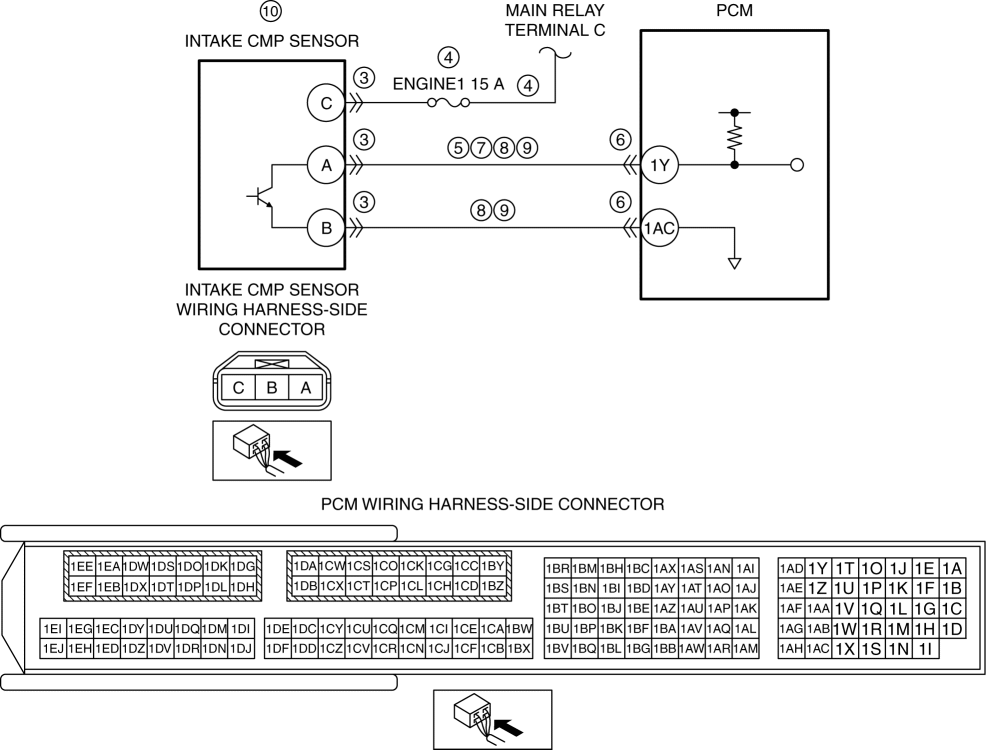|
|
| STEP | INSPECTION | ACTION |
| 1 | VERIFY FREEZE FRAME DATA (MODE 2)/SNAPSHOT DATA HAS BEEN RECORDED
| Yes | Go to the next step. |
| No | Record the FREEZE FRAME DATA (Mode 2)/snapshot data on the repair order, then go to the next step. |
| 2 | VERIFY RELATED REPAIR INFORMATION AVAILABILITY
| Yes | Perform repair or diagnosis according to the available repair information.
|
| No | Go to the next step. |
| 3 | INSPECT INTAKE CMP SENSOR CONNECTOR CONDITION
-
Switch the ignition off.
-
Disconnect the intake CMP sensor connector.
-
Inspect for poor connection (such as damaged/pulled-out pins, corrosion).
-
Is there any malfunction?
| Yes | Repair or replace the connector and/or terminals, then go to Step 13. |
| No | Go to the next step. |
| 4 | INSPECT INTAKE CMP SENSOR POWER SUPPLY CIRCUIT FOR SHORT TO GROUND OR OPEN CIRCUIT
-
Verify that the intake CMP sensor connector is disconnected.
-
Switch the ignition ON (engine off).
-
Measure the voltage at the intake CMP sensor terminal C (wiring harness-side).
-
Is the voltage B+?
| Yes | Go to the next step. |
| No | Inspect the ENGINE1 15 A fuse.
Go to Step 13. |
| 5 | INSPECT INTAKE CMP SENSOR SIGNAL CIRCUIT FOR SHORT TO GROUND
| Yes | If the short to ground circuit could be detected in the wiring harness:
If the short to ground circuit could not be detected in the wiring harness:
Go to Step 13. |
| No | Go to the next step. |
| 6 | INSPECT PCM CONNECTOR CONDITION
-
Disconnect the PCM connector.
-
Inspect for poor connection (such as damaged/pulled-out pins, corrosion).
-
Is there any malfunction?
| Yes | Repair or replace the connector and/or terminals, then go to Step 13. |
| No | Go to the next step. |
| 7 | INSPECT INTAKE CMP SENSOR SIGNAL CIRCUIT FOR SHORT TO POWER SUPPLY
-
Verify that the intake CMP sensor and PCM connectors are disconnected.
-
Switch the ignition ON (engine off).
-
Measure the voltage at the intake CMP sensor terminal A (wiring harness-side).
-
Is the voltage 0 V?
| Yes | Go to the next step. |
| No | Refer to the wiring diagram and verify whether or not there is a common connector between intake CMP sensor terminal A and PCM terminal 1Y.
If there is a common connector:
-
Determine the malfunctioning part by inspecting the common connector and the terminal for corrosion, damage, or pin disconnection, and the common wiring harness for a short to power supply.
-
Repair or replace the malfunctioning part.
Go to Step 13. |
| 8 | INSPECT INTAKE CMP SENSOR SIGNAL CIRCUIT AND GROUND CIRCUIT FOR SHORT TO EACH OTHER
| Yes | Refer to the wiring diagram and verify whether or not there is a common connector between the following terminals:
If there is a common connector:
-
Determine the malfunctioning part by inspecting the common connector and the terminal for corrosion, damage, or pin disconnection, and the common wiring harness for a short to each other.
-
Repair or replace the malfunctioning part.
Go to Step 13. |
| No | Go to the next step. |
| 9 | INSPECT INTAKE CMP SENSOR CIRCUIT FOR OPEN CIRCUIT
| Yes | Go to the next step. |
| No | Refer to the wiring diagram and verify whether or not there is a common connector between the following terminals:
If there is a common connector:
-
Determine the malfunctioning part by inspecting the common connector and the terminal for corrosion, damage, or pin disconnection, and the common wiring harness for an open circuit.
-
Repair or replace the malfunctioning part.
Go to Step 13. |
| 10 | INSPECT INTAKE CMP SENSOR
| Yes | Replace the intake CMP sensor, then go to Step 13. (See CAMSHAFT POSITION (CMP) SENSOR REMOVAL/INSTALLATION [SKYACTIV-G 2.5].) |
| No | Go to the next step. |
| 11 | INSPECT CKP SENSOR CONNECTOR CONDITION
-
Switch the ignition off.
-
Disconnect the CKP sensor connector.
-
Inspect for poor connection (such as damaged/pulled-out pins, corrosion).
-
Is there any malfunction?
| Yes | Repair or replace the connector and/or terminals, then go to Step 13. |
| No | Go to the next step. |
| 12 | VERIFY VALVE TIMING MECHANISM INSTALLATION
| Yes | Go to the next step. |
| No | Reinstall the following parts correctly, then go to the next step.
-
Timing chain
-
Camshaft sprocket
-
Crankshaft pulley
|
| 13 | VERIFY DTC TROUBLESHOOTING COMPLETED
| Yes | Repeat the inspection from Step 1.
Go to the next step. |
| No | Go to the next step. |
| 14 | VERIFY AFTER REPAIR PROCEDURE
| Yes | Go to the applicable DTC inspection. (See DTC TABLE [SKYACTIV-G 2.5].) |
| No | DTC troubleshooting completed. |
